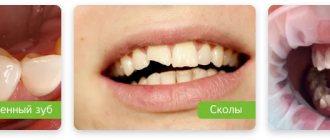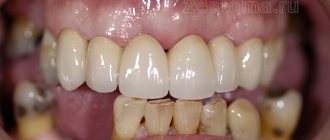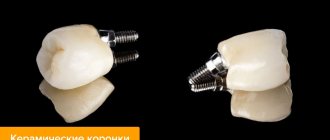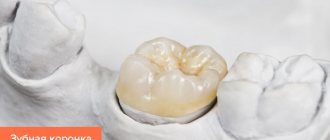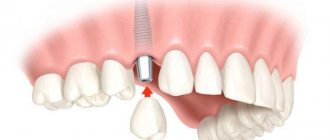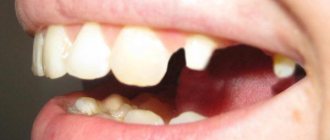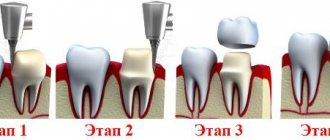- What kind of crowns are placed on teeth?
- Is it painful to grind down a tooth for a crown?
- Read more about teeth grinding
There are several reasons for using crown prosthetics.
Let us remind you that a crown is a tool for single prosthetics, which is used in the following cases: pathological pigmentation of teeth, violation of its anatomical shape, cracks, destruction of the coronal part by more than 60% of the tissue volume. To install a crown, the patient will need to go through the following steps:
- Diagnostics.
- Preparation of the tooth stump.
- Taking impressions.
- Making a crown.
- Fitting and final installation.
What kind of crowns are placed on teeth?
The following prostheses are used for dental prosthetics with crowns:
- Metal-ceramic is a budget-friendly, strong and durable crown option. The base of the prosthesis is metal, the top lining is ceramic. This ensures its strength and external aesthetics.
- All-ceramic - crowns for the front teeth are made from ceramic, since the material is not suitable for the significant chewing loads that are inherent in the lateral and chewing teeth.
- Zirconium dioxide is a premium material in modern orthopedics, used to restore both anterior and chewing teeth, as it has unsurpassed strength and naturalistic aesthetics today.
When is a doctor needed?
If your teeth ache for longer than 7 days after grinding, you should make an appointment with your doctor. The reason for contacting a specialist may also be:
- inflammation and bleeding of gums,
- the appearance of neoplasms on the mucous membrane,
- bad breath,
- pain when chewing and brushing teeth.
The listed symptoms cannot be ignored. Even with minor discomfort, it is better to consult a doctor to exclude the development of serious diseases.
What is meant?
Metal ceramics – two-layer prosthesis. The bottom layer is metal, the top layer is ceramic lining. In any case, such a product cannot be “thin”. This means that in order for the artificial tooth to be the ideal size, the stump will have to be considerably ground. In most cases, preparation will require depulpation of the nerve. Naturally, all this is done under local anesthesia, and the patient does not feel pain. Let us immediately note that while the dental technicians are making the prosthesis, the doctor will cover the ground tooth with a temporary “cap” in order to avoid hyperesthesia, a reaction to cold or hot.
Zirconium is not only the most durable and beautiful, but also the thinnest prosthesis. To install a zirconium dioxide crown, the tooth can be ground only slightly. In most cases, pulp preparation is not required. Many patients refuse anesthesia because there is no pain during the process of removing the top layer of enamel. If a person has a low pain threshold, then doctors use local or topical anesthesia so that the person feels physically and emotionally comfortable.
The thickness of the ceramic crown is average - between “thick” metal ceramics and “thin” zirconium. This means that the degree of grinding, and as a result, the level of trauma of the procedure, is determined individually in each specific case.
Author:
Mayorov Andrey Mikhailovich
Specialization:
orthopedic dentistry, dental prosthetics, implant installation
How to remove dental crowns -
Unfortunately, we must also note the fact that sometimes situations arise when the crown needs to be removed. For crown removal, the price for 2021 will be about 1000 rubles per unit. The need to remove the crown may be due to the following reasons...
- With poor preparation of the tooth for a crown - according to statistics, in 60-70% of cases, the root canals of the teeth are filled poorly, which leads to the development of inflammation and the need for re-treatment or removal of the tooth. You can find out more about poor-quality preparation of teeth for prosthetics, what this leads to, and what to do about it here .
- With manufacturing errors - for example, the crown did not fit tightly around the neck of the tooth, and therefore, within days, the destruction of the tooth tissue began. Metal-ceramics or metal-free ceramics could chip a large fragment of the ceramic mass, which may not be repairable and require replacement of the crown (24stoma.ru).
- Scheduled replacement of crowns is necessary - all crowns have their own service life, and they will have to be changed periodically. It should be noted that high-quality modern crowns can last 8-10 years, or even more.
Removing crowns: video
And here the question always arises: does it hurt to remove the crown... It can indeed be a little painful, and therefore the procedure is performed under local anesthesia. Removing cermets, for example, is very difficult. The crown is sawed using special discs and burs, and cases of damage to the gums next to the tooth are not uncommon. We hope that the article on the topic: How to put crowns on teeth was useful to you!
Sources:
1. Personal experience as a dentist, 2. “Orthopedic dentistry. Textbook" (Trezubov V.N.), 3. National Library of Medicine (USA), 4. "Orthopedic treatment with fixed prostheses" (Rozenstiel S.F.), 5. "Crowns and bridges in orthopedic dentistry" (Smith B .).
Stages of the procedure for installing a crown
The crown installation procedure is usually carried out in two stages.
Each stage is carried out separately, and the patient visits the dentist twice to install the crown.
The first stage includes: 1) preparing (grinding) the tooth, 2) taking an impression of the tooth, and 3) installing a temporary crown. The duration of the procedure is from 30 minutes to one hour.
Between the patient's two visits to the dentist, the crown is made in the laboratory of the adult dentistry clinic. This process usually takes about two weeks.
In the second stage, the dentist places the finished crown on the tooth, using filling material to secure it. The procedure takes about 20 minutes.
One-stage crown installation .
A variation of the main method is to install a crown in one step. If the dentist has all the necessary equipment at his disposal, the procedure will take an hour or two.
The first stage of crown installation
Preparing your teeth
Before the crown procedure begins, the dentist anesthetizes both the tooth and the surrounding gum area.
If the root of the dental canal is sealed, dental anesthesia is not needed. However, the dentist may consider it necessary to anesthetize the gums.
Preparation (grinding) of the tooth.
The tooth must be ground on all sides to reduce its size, since crowns must have a certain minimum thickness to ensure sufficient strength. Most crowns are about two millimeters thick. If the crown is porcelain, then the thickness of the porcelain layer should be sufficient to create visible natural translucency.
Additional reduction in tooth size.
During the process of grinding a tooth, the dentist is obliged to remove all damage from it, including poorly installed, “wobbly” or poor-quality fillings. As a result, most of the tooth may be removed. (There is no need to worry about this. The crown will be thicker in such areas).
The closer the tooth is in contact with the inside of the crown (the greater the correspondence between the contacting surfaces), the more firmly the crown will hold.
The prepared tooth must have a certain shape.
The dentist not only reduces the size of the tooth, he gives it the desired shape. The tooth must have a cone shape with a slight bevel angle so that a crown (a hard, inflexible shell) can be placed on it.
The correct shape of the ground tooth should ensure a tight fit and good fixation of the crown.
For a quality installation, it is not enough to simply place the crown on the filling material. The shape of the tooth is of great importance in ensuring a tight fit and reliable fixation of the crown.
The closer the shape of the ground tooth matches the shape of the inside of the crown, the better the crown will hold.
In cases where a large portion of the tooth is missing or significantly damaged, the dentist “builds on” the tooth with filling material (enlarges it) before filing the crown.
After grinding the tooth, the dentist must make an impression of it by applying impression material.
Most dentists use a special paste or powdered substance as an impression mass that has the properties of an impression mass.
It is also necessary to take impressions of the teeth located opposite the ground tooth (that is, the teeth that will come into contact with the crown when chewing). A bite impression is also taken to determine at what angle the patient's teeth meet.
How is the impression used?
The finished impression is sent to a dental laboratory, where a plaster copy is made of it to make a crown.
A plaster copy is an exact reproduction of the crowned tooth and adjacent teeth. Therefore, if the crown is made according to the dimensions of the copy, it will fit exactly on the tooth. In some cases, minor adjustments are still required.
Depending on the individual characteristics of the tooth, the work on making a crown in the laboratory takes about two weeks.
In addition to the procedure:
Some dentists have state-of-the-art milling machines that can be used to design and fabricate a crown right in the office.
Installation of a temporary crown
If the crown is made in a laboratory, you will have to wait about two weeks. At this time, you can install a temporary crown.
A temporary crown will protect your teeth and prevent them from moving.
A temporary crown is usually made of plastic, sometimes a metal-ceramic crown is available. Sometimes, for this purpose, blanks are taken and adjusted to a specific tooth, or they are made according to the dentist’s sketch.
The temporary crown is secured with a filling compound, which is easily removed before installing the permanent crown.
Choice of crown color.
If your new crown has a porcelain surface, your dentist will need to determine what shade of porcelain matches the color of the teeth adjacent to the crown.
The dentist uses a set of small samples in the form of teeth of different shades. This set of samples is called a “shade palette.”
Individual samples are applied in turn to the place where the crown will be installed, and the most suitable one is selected.
Crown installation stage.
Once the crown is made, the dentist can begin installing it.
- Removing the temporary crown
At this stage it is necessary:
Give anesthesia. This stage is not always necessary. Often the process of installing and securing the crown is painless for the patient.
Remove the temporary crown and remove any remaining filling material from the tooth.
- Assessing suitability and appearance of the crown.
Before placing a crown, the dentist must ensure that it is suitable and in good appearance. The assessment process includes:
Checking the strength of the attachment - the dentist places the crown on the tooth and checks the tightness of the fit using dental floss and tapping the tooth with an instrument, while the patient is asked to slightly squeeze the teeth.
After this, the doctor removes the crown, then puts it on again, slightly changing its position, removes it again, and this is repeated several times until the crown takes the desired position relative to adjacent and opposite teeth.
Checking the appearance. – Additionally, and in some cases mandatory, for example, when a dental crown is visible when you smile, the dentist should give you a mirror and ask you to evaluate the shape and color of the crown.
Do not hesitate to express your opinion and ask the doctor questions, and this must be done before the filling material hardens, then it will no longer be possible to make some changes (such as color changes and even some shape changes).
Planting the crown on cementing material
- Cementing the crown
If both you and the dentist feel that the crown is installed correctly and looks good, cementation can be done. For this:
Dental cement is placed inside the crown, after which it is placed on the tooth.
When the cement begins to harden, the dentist uses a dental instrument and scrapes off the excess cement that protrudes beyond the edges of the crown.
This completes the crown placement procedure.
Precautions after placing a crown
The dentist will explain to you what to do in the first hours after the crown is placed. For example, when using some types of dental cement, it is recommended to avoid impacting the crown (avoid eating too hard or sticky foods) until the cement has fully cured.
After administering anesthesia, caution should be exercised until the numbness subsides. Otherwise, you may bite your lip or cheek, and quite hard.
After the numbness has passed, the next day or a little later, lightly clench your teeth to make sure that the crown does not cause discomfort when opening and closing your mouth. If you feel discomfort, tell your dentist and he will correct the problem (usually by grinding the surface of the crown). If this is not done, complications, sometimes serious, are possible.
What inconveniences can you encounter after prosthetics?
Dentists installing dentures in Moscow warn in advance about possible discomfort that may manifest itself:
- noticeably irritating sensation of a foreign body in the oral cavity;
- pain caused by the pressure of the structure on the supporting teeth and especially the gums;
- rubbing of mucous membranes, redness and swelling, formation of bedsores on the gums;
- a feeling of poor closure of the jaws and teeth;
- increased salivation caused by the perception of the prosthesis as food that needs to be easier to move from the mouth to the throat;
- the appearance of gagging as a reaction to the presence of a foreign body in the mouth;
- impaired diction, which can be caused by even the best removable dentures (the tongue needs time to get used to changing position when pronouncing sounds);
- partial loss of taste of products caused by the closure of certain areas of the oral mucosa by the prosthesis.
